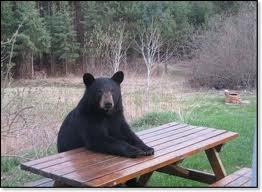Garbage = Buffets for Bears
With apologies to Pooh, Smokey, Yogi, Corky and other well behaved bears, we must discuss the actions of less mannerly bruins … who have earned the title of “nuisance bears.”
These critters are getting into trouble because, to them, your garbage is fine dining.
The worst part? They’re losing their fear of humans.
Easily accessible garbage is irresistible to a hungry black bear. Unfortunately, it’s also a major threat to its survival. Bear-proofing your garbage could add years to the lives of some of Georgia’s magnificent wild black bears.
“Bears become habituated when people feed them – whether intentional or not,” explains Adam Hammond, wildlife biologist with the Georgia Department of Natural Resources’ Wildlife Resources Division. “When a bear learns that it can get a ‘free meal’ from garbage, it’s going to return again and again until eventually it loses its natural fear of humans. This is how many human-bear conflicts begin, and the bear becomes labeled a nuisance.”
Homeowners, homeowner associations and business owners in known bear areas can help reduce human-bear conflicts by taking these important steps to secure their garbage.
- Use bear-proof containers or put garbage inside a garage or other enclosed area.
- Place garbage cans at the curb on the day of pick-up, rather than the night before.
- Installing an electric fence around garbage storage areas may help.
- Remove food scraps from grills and fire pits daily.
- Rinse food cans and wrappers before disposal.
- Keep garbage cans clean and deodorize them periodically.
- Install bear-proof trash bins on dumpsters, with reinforcing lids or latch mechanisms.
Garbage is just one of the many non-natural food items that attract bears. Birdseed and pet food round out the top three most common types of attractants. Homeowners in known bear areas are advised to bring pet food indoors and remove birdfeeders from April through November.
At the very least, bird feeders should be taken in at night and any spillage cleaned up daily. If bears find your feeders, the “bear feeders” should be taken down immediately and not put out again until bears have entered their dens in late November.
In Georgia, there are three population centers for black bears. These include the North Georgia mountains, the Ocmulgee River drainage system in central Georgia and the Okefenokee Swamp in the southeastern part of the state. However, black bears can and do range over larger areas, especially in early spring and late summer when natural food sources are scarce.
“The best and most effective way to resolve human-bear conflicts is to remove the attractant,” Hammond says. “In most cases, that simply means making trash, birdseed, pet food and other non-natural food items inaccessible.”
The black bear is a symbol of Georgia’s natural diversity, the only bear found in the state and a high-priority species in the state’s Wildlife Action Plan, a comprehensive conservation strategy. Though now considered the most common bear in North America, the species was nearly eradicated from Georgia by the 1930s due to unregulated market hunting, poaching and large-scale habitat loss.
Sound wildlife management practices have restored Georgia’s black bears to a thriving population estimated at 5,100 bears statewide. Your local library will let you check out an informational DVD entitled, “Where Bears Belong: Black Bears in Georgia.”
Click Here for Black Bear Information
